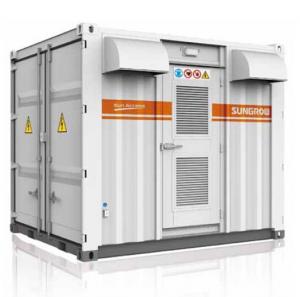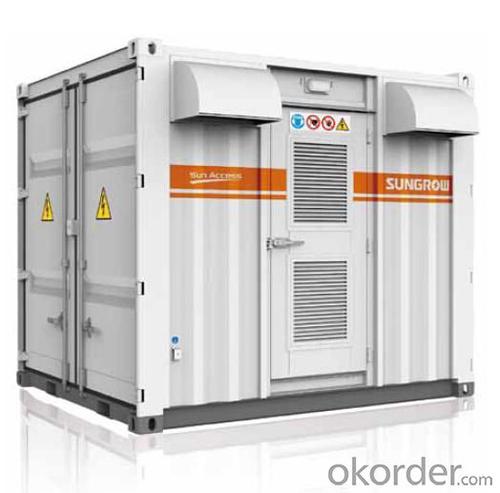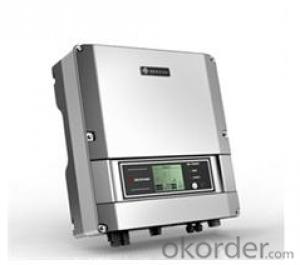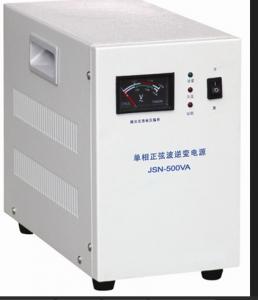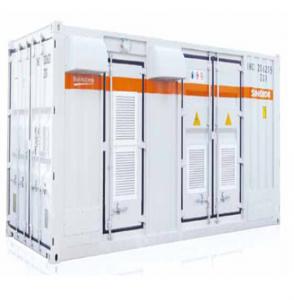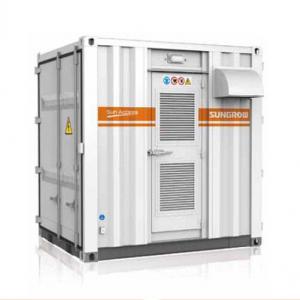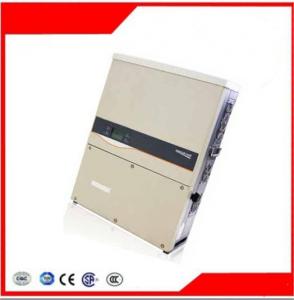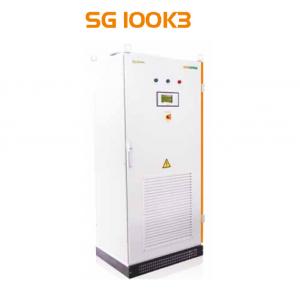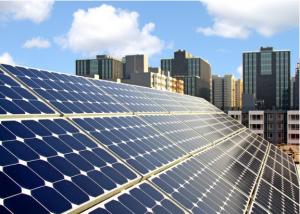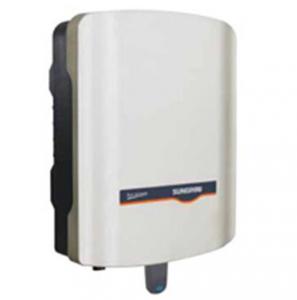3000 Watt Solar Inverter Photovoltaic On-Grid Connected Inverter SG1000TS-M PV Inverter
- Loading Port:
- China Main Port
- Payment Terms:
- TT or LC
- Min Order Qty:
- 500000 unit
- Supply Capability:
- 3000000 unit/month
OKorder Service Pledge
OKorder Financial Service
You Might Also Like
1. Structure of Photovoltaic On-Grid Connected Inverter SG1000TS-M PV inverter Description
A solar inverter, or PV inverter, or Solar converter, converts the variable direct current (DC) output of a photovoltaic (PV) solar panel into
autility frequency alternating current (AC) that can be fed into a commercial electrical grid or used by a local, off-grid electrical network.
It is acritical BOS–component in a photovoltaic system, allowing the use of ordinary AC-powered equipment. Solar inverters have
special functions adapted for use with photovoltaic arrays, including maximum power point tracking and anti-islanding protection.
Suitable for 50Hz/60Hz grid, could be used in Europe, Middle East Asia, Southeast Asia and Australia.
2. Main Features of the Photovoltaic On-Grid Connected Inverter SG1000TS-M PV inverter
• 7 square meters area for megawatt-class equipment
• Transport and installation by forklift, more flexible and economical
• Open door design of four sides, easy for installation and maintenance
• More flexible for inner devices overall replacement
• Efficient cooling patented design of combination inline and ventilation
• Patented structure design of inlet and outlet, effective dust proof
• Thick and efficient heat insulation layer
• Advanced three-level circuit structure improves product performance
• 8-MPPT, wide MPP voltage range, Flexible setting of 2 /4/ 8 MPPT
• Comprehensive modular ,Draw-type design
3. Photovoltaic On-Grid Connected Inverter SG1000TS-M PV inverter Images
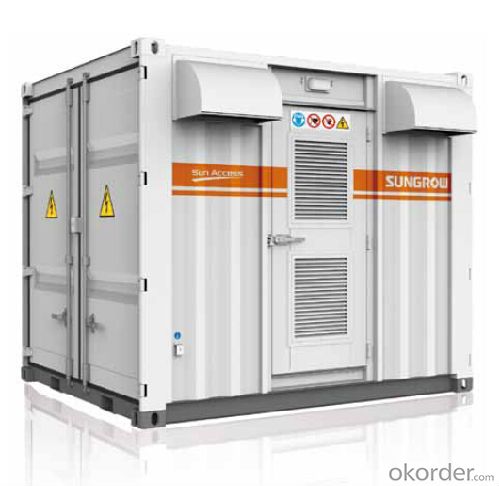
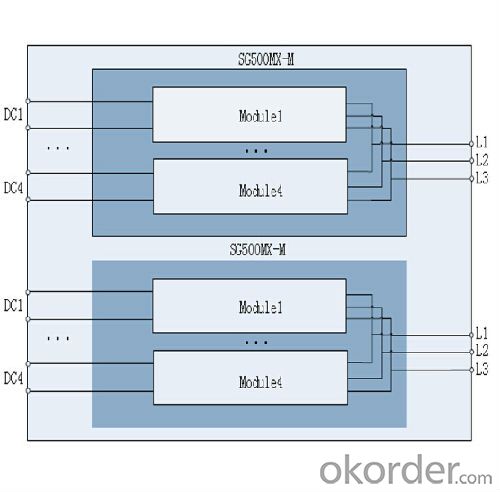
4. Photovoltaic On-Grid Connected Inverter SG1000TS-M PV inverter Specification
Input (DC) |
|
Max. DC power (@ cos φ =1) | 1120kW |
Max. input voltage | 1000V |
Start voltage | 520V |
Min. working voltage | 500V |
Max. input current | 2280A |
MPPT voltage range | 500~850V |
Number of MPPTs | 2, 4, 8 |
Number of DC inputs | 2 x 8 |
|
|
Output (AC) |
|
Rated power | 1000kW |
Max. output AC power | 1100kVA |
Max. output current | 2036A |
THD | <3%(at nominal power) |
Nominal AC voltage | 315V |
AC voltage range | 252~362Vac |
Nominal grid frequency | 50Hz / 60Hz |
Grid frequency range | 47~52Hz / 57~ 62 Hz |
Power factor | >0.99@default value at nominal power, adj. 0.9 overexcited ~0.9 underexcited |
Isolated transformer | No |
DC current injection | <0.5% In |
|
|
Efficiency |
|
Max. efficiency | 98.80% |
European efficiency | 98.60% |
|
|
Protection |
|
DC disconnect device | Switch-disconnector with fuses |
AC disconnect device | Switch-disconnector with fuses |
DC overvoltage protection | Yes |
AC overvoltage protection | Yes |
Grid monitoring | Yes |
Ground fault monitoring | Yes |
Overheat protection | Yes |
Insulation monitoring | Yes |
|
|
General Data |
|
Dimensions(W×H×D) | 2991X2591X2438mm |
Weight | Containing DC Distribution Cabinet: 5169kg, Not Containing DC Distribution Cabinet: 4834kg |
Operating ambient temperature range | -35~+50℃ |
External auxiliary supply voltage | 380V |
Cooling method | Temperature controlled air-cooling |
Ingress protection rating | IP54 |
Allowable relative humidity range | 0~95%, non -condensing |
Max. operating altitude | 6000m (derating > 3000m) |
Communication port/protocols | Standard: RS485/ Modbus, Internet Options: CDT, DNP3.0, 101, 103, 104, GPRS/CDMA module |
5. FAQ of Photovoltaic On-Grid Connected Inverter SG1000TS-M PV inverter
Q1. What is the difference between inverter and solar inverter?
A1. Inverter only has AC inpput, but solar inverter both connect to AC input and solar panel, it saves more power.
Q2. What is the difference between MPPT&PWM?
A2. MPPT has higher efficiency, it can track the max power point and won't waste energy.
- Q: What is the role of a solar inverter in maximizing solar panel output?
- The role of a solar inverter in maximizing solar panel output is to convert the direct current (DC) generated by the solar panels into alternating current (AC) which can be used to power electrical devices in homes or businesses. The inverter ensures that the AC output is synchronized with the grid's frequency and voltage, allowing for efficient and effective utilization of solar energy. Additionally, the inverter also helps in monitoring and optimizing the performance of the solar panels, ensuring that they operate at their maximum efficiency and produce the highest possible output.
- Q: Can a solar inverter be easily integrated into an existing electrical system?
- Yes, a solar inverter can be easily integrated into an existing electrical system. It can be connected to the main electrical panel to convert the DC power generated by solar panels into AC power that can be used to power appliances and devices in the building. However, it is important to consult with a professional electrician to ensure proper installation and compatibility with the existing system.
- Q: Can a solar inverter convert DC power to AC power?
- Yes, a solar inverter can convert DC power generated by solar panels into AC power that is suitable for use in homes and businesses.
- Q: What is the role of a power monitoring feature in a solar inverter?
- The role of a power monitoring feature in a solar inverter is to constantly monitor and measure the amount of power being generated by the solar panels. This feature allows users to track the performance of their solar system, detect any issues or malfunctions, and optimize the energy output for maximum efficiency. It provides real-time data on the power production, enabling users to make informed decisions regarding energy usage and grid integration.
- Q: Can a solar inverter be used for three-phase power systems?
- Yes, a solar inverter can be used for three-phase power systems. Three-phase solar inverters are specifically designed to convert the DC power generated by solar panels into AC power for three-phase electrical systems. These inverters are capable of handling the higher voltage and power requirements of three-phase systems, making them suitable for commercial and industrial installations.
- Q: How does a solar inverter convert DC to AC power?
- A solar inverter converts DC (direct current) power generated by solar panels into AC (alternating current) power that is compatible with household and grid electricity. It does this by utilizing electronic components such as transistors and capacitors to convert the fixed voltage and current of DC power into a fluctuating form that resembles the waveform of AC power. The inverter then boosts the voltage to the desired level and synchronizes the frequency of the AC power with the grid's frequency before feeding it into the electrical system.
- Q: Can a solar inverter be used in a commercial or industrial setting?
- Yes, a solar inverter can be used in a commercial or industrial setting. In fact, they are commonly used in these settings to convert the direct current (DC) electricity generated by solar panels into alternating current (AC) electricity that is suitable for use in commercial or industrial buildings. Solar inverters are designed to handle larger electricity loads and are capable of efficiently powering various electrical equipment and machinery in such settings.
- Q: How do you maintain a solar inverter?
- To maintain a solar inverter, regular cleaning of dust and debris is essential to ensure efficient operation. Additionally, monitoring the inverter's performance and checking for any abnormal readings or error messages is important. It is also recommended to inspect the wiring connections for any loose or damaged parts and to keep the inverter's ventilation system clear from obstructions. Regular servicing by a professional technician is recommended to identify and address any potential issues before they become major problems.
- Q: How does a solar inverter handle voltage fluctuations?
- A solar inverter handles voltage fluctuations by constantly monitoring the input voltage from the solar panels and adjusting its output voltage accordingly. It maintains a stable output voltage even when there are fluctuations in the input voltage, ensuring that the electricity generated by the solar panels is suitable for use in the electrical grid or for powering appliances.
- Q: What are the advantages of using a transformerless solar inverter?
- One advantage of using a transformerless solar inverter is increased efficiency. Transformerless inverters have a higher efficiency rating compared to inverters with transformers, which means more of the solar energy is converted into usable electricity. Additionally, transformerless inverters are lighter and more compact, making them easier to install and transport. They also tend to have a longer lifespan and require less maintenance compared to inverters with transformers.
Send your message to us
3000 Watt Solar Inverter Photovoltaic On-Grid Connected Inverter SG1000TS-M PV Inverter
- Loading Port:
- China Main Port
- Payment Terms:
- TT or LC
- Min Order Qty:
- 500000 unit
- Supply Capability:
- 3000000 unit/month
OKorder Service Pledge
OKorder Financial Service
Similar products
Hot products
Hot Searches
Related keywords
